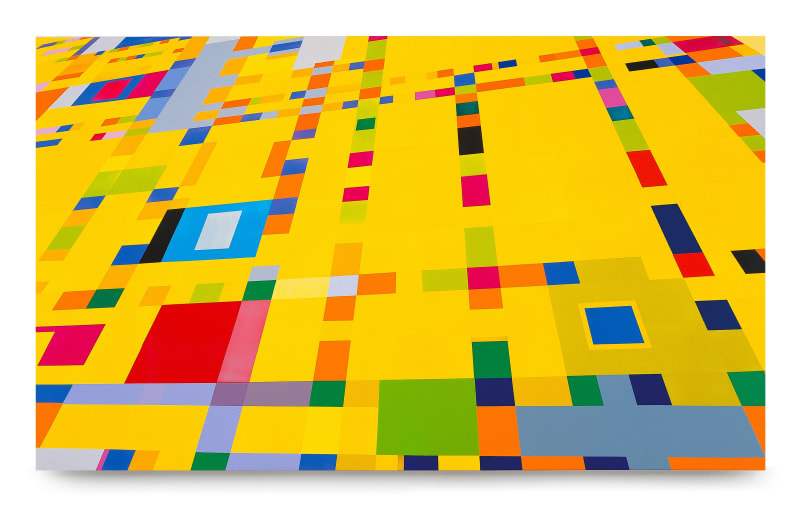Torben Giehler has brought the modernist grid into the 21st century. The future we’ve all been waiting for is here. Our daily lives are fast-paced and electronic; an endless barrage of information is consumed but not quite digested before the next morning’s dose. Giehler comes along at an invigorating time in contemporary painting. The early 90s were a boon to video and new media. The word digital started gradually to filter its way into the mainstream lexicon. In some circles then and even today painting was thought to have seen better days. Could a medium that had from perspective through minimalism helped revolutionize the way we look at things be so easily dismissed? Was it the two-dimensional structures of the canvas that seemed archaic or was it the medium itself?
New media seemingly outdistanced painting in incorporating fresh ways to extend the discourse of art. How could painters make their work relevant to the burgeoning digital society while remaining true to their historical precedents? Surely this is an issue on the mind of Torben Giehler. The last five years of the 20th Century saw a resurgence of painting, and the art-world, always cyclical, began promoting it with a vengeance. What is the difference this time around?
A young artist, Giehler is at the beginning of his career arc yet his worldliness is clearly evident in these crystalline representations. Initiated by the technological revolution, his geometric abstractions are hyper-riffs on the modernist grid yet privy to the currents of the moment. His post-millennial generating has come of age in step with the hardware and information at our disposal, consciously dislodging its key elements into a uniformly thematic whole. Think of Mondrian on ecstasy; the cerebral in tandem with the virtual, motion depicted in a vibrant acrylic spectrum alternating between natural and synthetic colors.
These recent paintings start out as freehand color drawings of architecture that stand out in a void. While these drawings specifically associate with space, line and architectural volume, their isolate nature are actually reminiscent of Ed Rusha’s photographs of gasoline stations and parking lots set in barren suburban landscapes. Giehler then takes a digital photograph of a particular drawing, downloading it onto his computer. Using Photoshop to deconstruct and rework the initial drawing of the building or cityscape, he essentially pulls apart the pieces and refits them together on the computer screen before printing up a blueprint for the actual painting. As each canvas evolves, he allows room for spontaneous changes from the printed schematic, giving over to unexpected improvisation. There is no future without the present. There is no future like the present.
Giehler’s timely paintings are about a future that we talk about and conceive of, but that is actually here and now and perhaps will consume us all. Their diagonal perspectives and precisely demarcated, almost curvy boxes of color give one a sense of virtual time travel. Some have the aerial view of an airport landing strip, others of a racecar track. Always there is this rush of harmonious animate colors and that ambient sense of movement and distance found in interactive media.
It’s become clear that the digital revolution has found its way into painting, forcing painters who work in this traditional medium to explore and utilize its myriad tools in answer to technology’s ubiquity. Painters of Torben’s generation are fully conscious about their aesthetic choices. They’ve honed in on the digital zeitgeist and its liquid dynamic. Rather then catch up with the technology, in Giehler’s case it’s natural extension of the brush. He distills the abstract information that comprises digital language and disseminates its useful components, discarding the unnecessary.
There is irony in all of this. Technology was the domain of engineers and techies. Digital communications rather than the natural world now influence the major shifts in contemporary art. Since 1998 the mainstream landscape has changed dramatically. Our language alone has adapted to the cyber lexicon and therefore our collective psyche has had to follow. The global chain events spurred by the communications industry and lower cost technological devices have made the 20th century a relic in almost no time at all. The gap between the last two years is huge!
We can only speculate about how the next few years will turn out. After the initial rush of technology, do we begin to slow down or do we continue accelerating? What will be the art historical challenge painters must tackle in response to virtual realities and its effect on vocabulary and materiality? In the end the digital zeitgeist informs us all. What artist like Torben Giehler do persuasively is to bridge the previously perceived technological gap between digital media and painting, giving their formal issues a parallel in both the real and the virtual.
